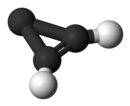Cyclopropenylidene
|
|
|||
| Names | |||
|---|---|---|---|
|
IUPAC name
Cyclopropenylidene
|
|||
| Identifiers | |||
|
16165-40-5 |
|||
| 3D model (Jmol) | Interactive image | ||
| ChemSpider | 4937408 | ||
| PubChem | 6432149 | ||
|
|||
|
|||
| Properties | |||
| C3H2 | |||
| Molar mass | 38.05 g·mol−1 | ||
|
Except where otherwise noted, data are given for materials in their standard state (at 25 °C [77 °F], 100 kPa).
|
|||
|
|
|||
| Infobox references | |||
Cyclopropenylidene, or c-C3H2, is an aromatic molecule belonging to a highly reactive class of organic molecules known as carbenes. Due to its reactivity, cyclopropenylidene is only seen terrestrially in the laboratory. However, it is found in significant concentrations in the interstellar medium (ISM) due to the extreme environment. The linear isomer of c-C3H2 is also found in the ISM, but its column density is generally about an order of magnitude lower.
The astronomical detection of c-C3H2 was first confirmed in 1985. Four years earlier, several ambiguous lines had been observed in the radio region of spectra taken of the ISM, but the observed lines were not identified at the time. These lines were later matched with a spectrum of c-C3H2 using an acetylene-helium discharge. Surprisingly, c-C3H2 has been found to be ubiquitous in the ISM. Detections of c-C3H2 in the diffuse medium were particularly surprising because of the low densities. It had been believed that the chemistry of the diffuse medium did not allow for the formation of larger molecules, but this discovery, as well as the discovery of other large molecules, continue to illuminate the complexity of the diffuse medium. More recently, observations of c-C3H2 in dense clouds have also found concentrations that are significantly higher than expected. This has led to the hypothesis that the photodissociation of polycyclic aromatic hydrocarbons (PAHs) enhances the formation of c-C3H2.
The major formation reaction of c-C3H2 is the dissociative recombination of c-C3H3+.
...
Wikipedia


